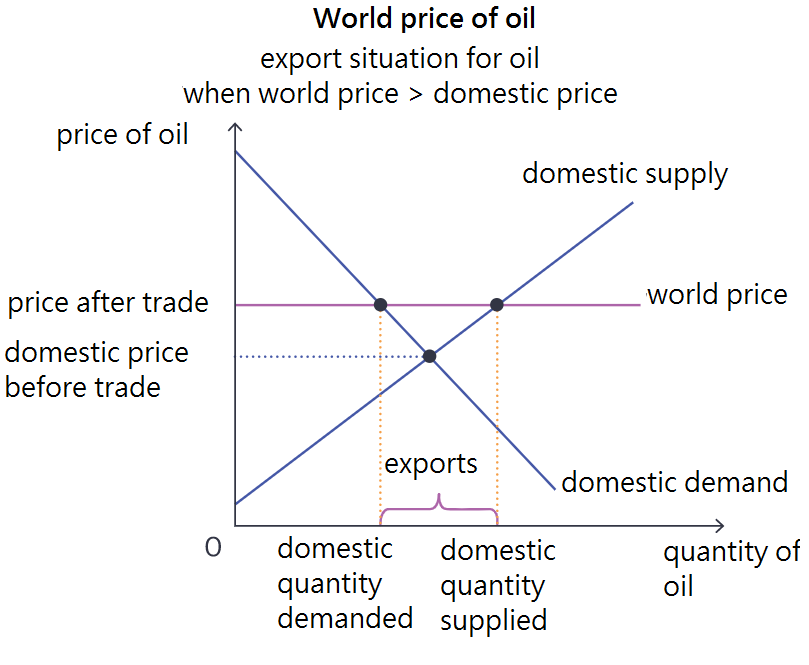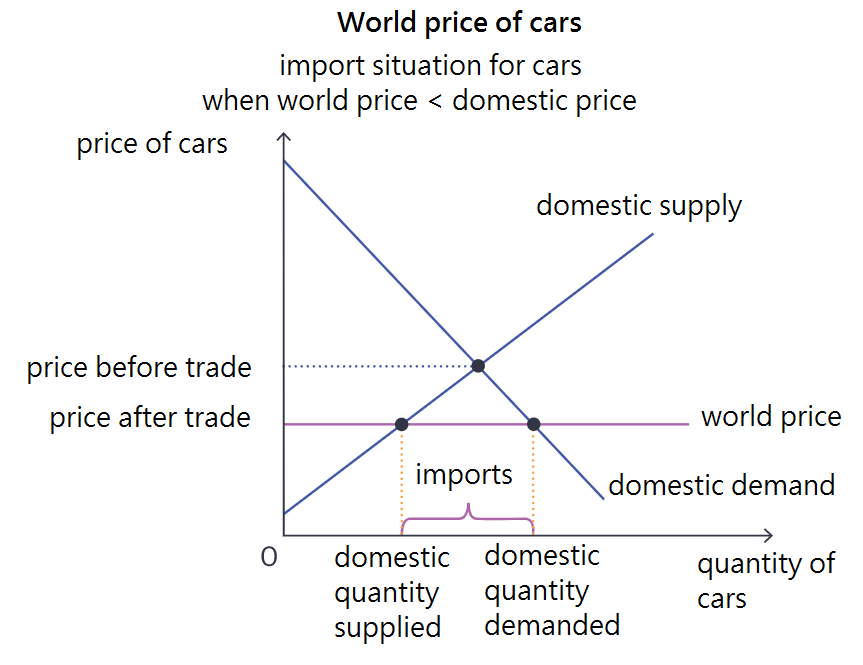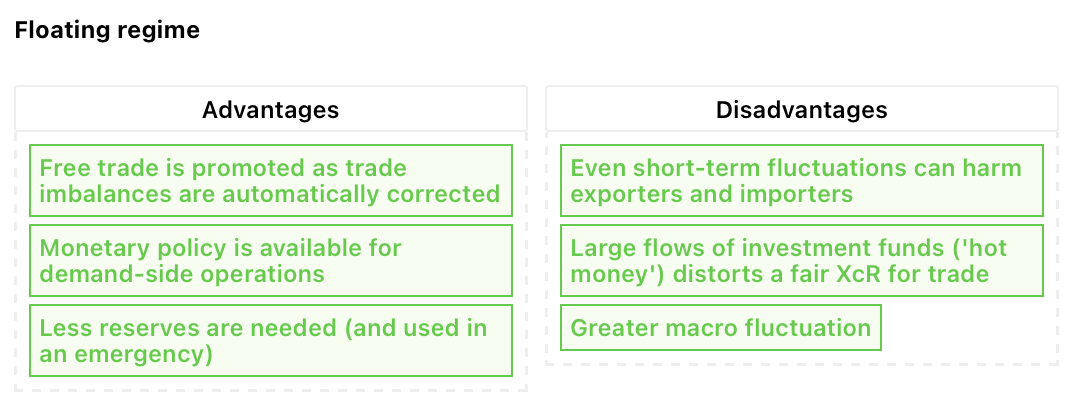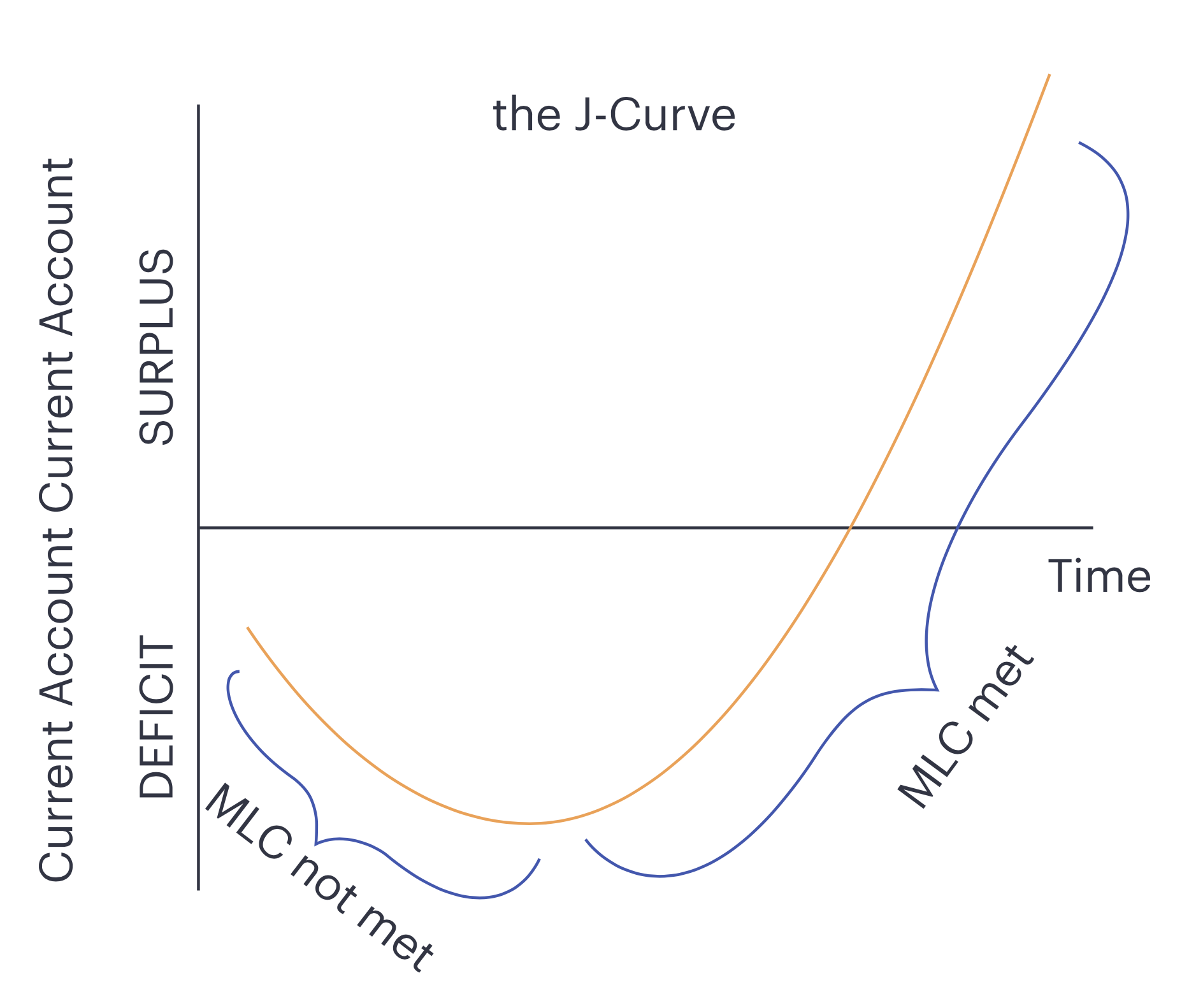Unit 4: The Global Economy
1/159
Earn XP
Description and Tags
Name | Mastery | Learn | Test | Matching | Spaced | Call with Kai |
|---|
No study sessions yet.
160 Terms
international trade
the transnational exchange of goods and services which involves the sale of exports and purchase of imports
factor endowment
the quantity and quality of FOPs available in a country
benefit of trade - increased competition
domestic firms find greater competition as overseas firms can produce goods and services of higher quality and quantity at lower prices
local firms are forced to become more efficient and innovative which brings benefits to the consumer
benefit of trade - lower prices
more competition, efficiency, economies of scale due to the market being larger → lower average cost of production
domestic producers can buy FOPs from overseas which can be cheaper reducing the cost of production thus the final price
benefit of trade - greater choice
trade makes the market bigger, more goods and services from more firms are available
benefit of trade - acquisition of resources
different factor endowments mean different countries have resources suited to different FOPs
international trade can allow countries access to more natural and/or capital resources which would otherwise not be available thus bettering their production processes
benefit of trade - foreign exchange earnings
export earnings in the form of foreign currencies
exporting country can purchase goods and services from other countries (this is import expenditure)
benefit of trade - access to larger markets
greater quantity of consumers increases the quantity supplied which enables economies of scale
integration of economies through trading blocs further enables this
benefit of trade - economies of scale
increase in output lowers average costs of production
cost savings can be passed on to consumers in the form of lower prices
larger scale enables domestic businesses to utilise division of labour and specialisation, invest in capital machinery
benefit of trade - efficient resource allocation
international trade encourages an efficient allocation of scarce resources globally
relatively free international trade makes domestic firms increase the quality of their output due to overseas competition which improves resource allocation in the domestic economy
benefit of trade - efficient production
domestic and foreign firms engage in price and non-price competition
domestic consumers can access a greater quantity of goods and services at lower prices
inefficient and unproductive firms become uncompetitive so when competition increases they are forced to become more efficient in their production process
export situation diagram
when the world price is greater than the domestic equilibrium before trade occurs, producers benefit from free trade as they can export goods for higher prices and thus make more revenue and profits

import situation diagram
when the world price is less than the domestic equilibrium before trade occurs, consumers benefit from free trade as lower priced goods are imported and thus reduce the domestic equilibrium price

the world price
the world price is horizontal meaning that the world will supply/demand any quantity of the good at one price
it assumes that the country has no influence over the world price — is a price taker
the World Trade Organisation
only global organisation dealing with rules of trade between nations
help producers and importers conduct their business
representatives from 150 nations
formed in 1995
positive = globalising the economy, allowing more trade to happen more smoothly
negative = developed countries increasing trade with developing countries without considerations for labour and environmental practices
protectionism
the use of barriers to trade to safeguard an economy from excessive international trade and foreign competition
barriers to trade
obstacles to international trade imposed by a government to safeguard national interests by reducing the competitiveness of foreign firms
comparative advantage
economies should specialise in the goods and services which they have a relatively low opportunity cost for when producing
increases efficiency and expands production capacity
tariffs
specific tax on imported goods and services
implemented unilaterally or as part of a trading bloc
increase the costs of production for foreign firms which raises the price of imported goods, so makes domestic products relatively cheaper
most common form of trade protection
quotas
quotas = quantitative limits on the importation of a good into a country
implemented unilaterally or as part of a trading bloc
restrict supply at the expense of foreign firms
quota creates more scarcity so increases the price
domestic supply shifts with the quota, additional amount is is the imported quantity
export subsidies
form of financial assistance to domestic firms which lowers their costs of production to help them compete against foreign firms
production subsidies = help reduce costs of production, most common
export subsidies = targeted at protecting specific export orientated firms
consumers pay Pw but producers receive Ps
reduces the quantity imported as the shortage in the domestic market is mitigated
administrative barriers
the application of bureaucratic standards and regulations imposed on foreign firms in order to protect domestic firms and consumers
examples include strict rules for food safety, environmental standards, product quality
compliance increases costs for foreign firms
barriers can increase the time it takes for imports to enter the domestic market, allowing domestic firms to fill a gap first
regulations can be easier for domestic firms to meet due for social/economic/cultural reasons so give them a competitive advantage
embargoes
a form of administrative barrier that involves the use of bans on trade with a certain country
often due to political and/or economic disputes (sanctions)
can be made for health and safety reasons too
exchange controls
a form of administrative barrier involving restrictions on the quantity of foreign exchange that can be bought or sold by domestic residents
restricts the volume of foreign trade as money has to be exchanged for trade to occur
includes daily limits on the amount of money that can be exchanged by tourists and investors
globalisation
ongoing integration of national economies into global rather than national markets
a natural outcome of increasing trade
large companies end up controlling free markets, they operate in numerous countries which sets up global supply chains, these can take advantage of developing countries — labour and environmental standards are not the standard they would be in a developed country, other problems occupy governments in these countries
country with absolute advantage
most efficient producer for a particular good
if countries trade based on absolute advantage prices and opportunity cost are low
idea that countries should specialise in what they are good at making — they will be more efficient so can sell at the most competitive (lowest) price
minimal waste of resources as this is caused by inefficient production
limitations of comparative advantage
assumes comparative advantage is constant — capabilities and resources of countries can change for various reasons
assumes no barriers to international trade — arguments for protectionism, use of tariffs and quotas in the real world
transportation costs are not considered — it takes time and money to move goods between countries, a great distance can detract from or eliminate a comparative advantage
assumes perfect occupational mobility of resources — ideas that FOPs cab be switched between industries without any loss of efficiency, assumption of the PPC model
assumes perfect knowledge of pricing information for consumers and producers — complications from exchange rate fluctuations and relative inflation rates don’t allow for this
exchange rate
the value of one currency expressed in terms of another currency
floating exchange rate
the value of a currency is determined by the demand for and supply of the currency in the foreign exchange market
appreciation
a sustained increase in the value of one currency in terms of another under a floating exchange system
only happens when an increase in demand is not matched by a factor increasing the supply of that same currency or vice versa
depreciation
a sustained decrease in the value of one currency in terms of another under a floating exchange rate system
domestic demand for imports and impact on the exchange rate
when a good is imported into the domestic economy the supply of that country’s currency increases and demand for the overseas currency decreases
suppliers of domestic goods are paid in the domestic currency throughout the supply chain so
higher demand for imports = increase in supply of domestic currency = depreciation
foreign currency appreciates
foreign direct investment (FDI)
spending by multinational corporations (MNCs) in the domestic economy
inward FDI and impact on the domestic currency
foreign MNCs expanding their operations in the domestic economy
higher demand for domestic currency → appreciation
outward FDI and impact on the domestic currency
MNCs from the domestic economy expanding their operations in overseas markets
higher supply of domestic currency —> depreciation
portfolio investment
purchase of financial investments abroad such as the purchase of stocks, shared and bonds of overseas firms and governments
domestic investors have to purchase foreign currency to buy such financial investments
inward portfolio investment and impact on the currencies
spending in the domestic economy by foreign investors
higher demand for domestic currency —> appreciation of domestic currency
depreciation of foreign currency
outward portfolio investment and impact on the currencies
domestic investors investing in overseas markets
increase in domestic currency’s supply
increase in demand for overseas currency
depreciation of domestic currency
appreciation of foreign currency
remittances and impact on the currencies
movement of money when nationals working abroad send money back to their home country
money sent to family or own bank account
expats supply the foreign currency (they are being paid in it) and demand their home currency
depreciation of foreign currency
demand increases → appreciation of home currency
speculation
happens when a financial asset is purchased in the hope or anticipation that the resale value will be higher
investing in currencies
impacts the exchange rate when done a large scale
if the value of a currency is expected to rise demand for it will increase leading to appreciation
relative inflation rates
higher inflation → less demand for currency → depreciation
speculators will sell currency when it is subject to high inflation, this increases supply of the currency causing further depreciation
relative interest rates
investors may save in a currency with higher interest rates so they receive higher returns, increase in supply of original currency and increase in demand of foreign currency
reduced interest rates will lead investors to sell their investments in that currency leading to depreciation
relative growth rates
higher growth is indicative of higher AD
inflation may increase, interest rates increase
demand for that currency increases causing appreciation
economic growth → higher interest rates → appreciation
When a currency appreciates or when it is overvalued, domestic currency is more expensive compared to the trading partners’ currencies, so:
exports are more expensive for them—they buy less as per the law of demand
export (receipts) decrease—worsening the balance of trade, slowing aggregate demand (AD) (assuming PED > 1)
this could lead to a declines in export industries, thus less employment and less gross domestic product (GDP).
When the currency appreciates, trading partners’ products become less expensive, so:
imports are less expensive—they buy more as per the law of demand
import payments increase—worsening the balance of trade, slowing AD (assuming PED > 1)
this also makes domestic producers less competitive, thus less employment and less GDP.
positive impacts of currency appreciation
lower AD means inflation is lower
imported inputs/raw materials are less expensive for those industries that depend upon them
imported consumer goods are less expensive.
fixed exchange rate
government pegs one country’s value to another country’s value
managed exchange rates
a system where the government or central monetary authority intervenes periodically in the foreign exchange market to influence the exchange rate, when deemed necessary to maintain certainty and confidence in the economy
devaluation
deliberate attempt by the government to make their currency depreciate (shift the exchange rate down)
evaluation (revaluing a currency)
deliberate attempt by the government to make their currency appreciate (shift the exchange rate up)
crawling peg system
a form of fixed exchange rate system in which a currency is permitted to fluctuate within predetermined bands of exchange rates
consequences of an overvalued currency
currency overvalued → government wants ER to reduce → sells overvalued currency → supply increases → ER reduces
consequences of an undervalued currency
undervalued currency → government wants ER to increase → purchases undervalued currency → demand increases → ER increases
overvalued currencies
overvalued currency = the value of a currency is above its equilibrium value in the long run
shouldn’t happen in a free floating system due to the price mechanism
consequences are that imports become cheaper and exports become more expensive, downward pressure on inflation, domestic efficiency must increase to compete with foreign firms
undervalued currencies
undervalued currency = the value of a currency is below its equilibrium value in the long run
exports become relatively cheaper → economic growth and increased employment in export industries
imports become more expensive for domestic buyers → more domestic goods are bought → fewer leakages from the economy
How the reserve bank can revalue the currency
buy (demand) more of its currency on the forex by selling foreign reserves
increase interest rates.
How the reserve bank can devalue the currency
sell (supply) more of its currency on the forex by buying foreign reserves
decrease interest rates.
reasons to fix the exchange rate
eliminates uncertainty in international transactions
avoids inflation due to currency depreciation
avoids a loss of international competitiveness
imposes greater accountability on the government
consequences of currency appreciation
exported goods are more expensive for other countries to buy → less money comes in from exports → AD slows if PED>1 and domestic industries may decline
easier to buy imports → more money is spent on imports → AD slows if PED>1 and domestic producers are less competitive
imported raw materials are cheaper → cost of production decreases → SRAS increases → GDP and employment increase, inflation decreases
advantages and disadvantages of a fixed exchange rate

advantages and disadvantages of a floating exchange rate

the current account
records the flow of money for buying goods and services between a country and its trading partners
current account deficit
more money spent on imports than earned from exports
current account surplus
more money earned from exports than spent on imports
financial account
records the purchase of real and financial assets between a country and all other nations
financial account deficit
a country owns more assets overseas than foreigners own of that country’s assets
financial account surplus
more foreigners have domestic assets than the country has of foreign assets
balance of payments
a financial record of a country’s transactions, including exports and imports, with the rest of the world, usually over one year
components of the current account
can be remembered as GIST (goods, income, services, transfers)
current transfers
inflows and outflows of money that are not made in exchange for trade or any corresponding output of goods or services
includes: foreign aid, government grants, concessionary loans, donations and net remittances
net current transfers = current transfers from abroad minus current transfers sent abroad
income in the current account
inflows earned from foreign investments minus the outflows of factor incomes paid to foreign investors
sum of wages, interest, rent and profit (WIRP)
eg residents who earn income from foreign assets
the capital account
records the different forms of capital inflows and outflows of a country during a given time period, namely capital transfers and transactions in non-produced, non-financial assets
includes for example foreign currency flows, debt forgiveness, debt relief and transactions in non-produced, non-financial assets
capital transfers
different forms of capital inflows and outflows of a country
transactions in non-produced, non-financial assets
legal property rights to natural resources and intellectual property rights to intangible assets
capital account balance
net capital transfers + transactions in non-produced, non-financial assets
components of the financial account
transactions recorded relate to cross-border investment
comprised of four sections: foreign direct investment (FDI), portfolio investment, reserve assets, official borrowing
FDI = spending by multinational corporations (MNCs) in countries they are not headquartered in
portfolio investment = stock of investment assets
reserve assets = sticks of foreign currencies and liquid assets held by central banks
official borrowing = government borrowing
how the balance of payments works
overall BOP must always balance because in the long-term a country can only spend what it earns
possible to run a deficit in one component as it can be offset by a surplus in another
so theoretically:
overall BOP has a balance of zero
credit items are matched by debit items
deficits are matched by surpluses
for the BOP to balance: current account = capital account + financial account + errors and omissions
Marshal Lerner condition
states that a currency depreciation will only rectify a current account deficit if: PED(exports) + PED(imports) > 1
what happens when the MLC is not met (sum of PED is less than 1)
when PED exports = inelastic
currency depreciates → export price falls → TR falls
when PED imports = inelastic
currency depreciates → import price rises → TE (expenditure) rises
NX decreases (further into the negatives) worsening the current account deficit
the J-Curve effect
in the short term demand tends to be inelastic for imports and exports
producers and consumers take time to adjust to new prices (caused by exchange rate fluctuations)
y axis is current account in the appropriate currency and x axis is time
when a current depreciated the current account deficit worsens before it improves (after economic agents have adjusted)

economic integration
process of countries becoming more interdependent and economically unified
intensifies competitiveness among producers in a trading bloc → increased efficiency → lower prices + better goods for consumers
preferential trade agreement
a trade treaty between two or more countries, giving special or favourable terms and conditions of trade to member countries
reduction or removal of tariffs and other trade barriers
bilateral agreements, regional trade agreements, multilateral agreements
can be through the WTO
bilateral trade agreement
a preferential trade agreement between two countries, usually by mutual agreement to reduce or remove barriers to trade
2004 CEPA between China and Hong Kong
legally binding
are not bound by WTO rules as their scope can go beyond trade
regional trade agreement
a reciprocal trade agreement between two or more countries usually belonging to the same geographical region
examples: EU, APEC, CAFTA-DR, Mercosur
includes internal rules for member states to follow and external rules for dealing with non-member states
multilateral trade agreement
a legally binding preferential trade agreement between more than two countries and/or trade blocs, under the guidelines of the WTO
agreement and intention to reduce or remove international trade barriers between member countries
includes RTAs which follow the rules and regulations of the WTO
trading bloc
a group of countries that agree to economic integration and freer international trade by reducing or removing trade barriers with each other
free trade agreement
a type of trading bloc between member states that agree to trade freely with each other but can impose separate trade restrictions on non-member countries
least economically integrated type of trading bloc
examples are USMCA (US, Mexico, Canada), EFTA and SAFTA
customs union
a trading bloc whereby member countries engage in free trade with each other but impose a common external tariff when trading with non-member states
reduces administrative burdens
negotiate collectively with non-member states
revenue from tariffs is combined
biggest is the EU
common market
a customs union that allows the free movement of factors of production between member countries
most integrated type of trading bloc
has a common external tariff (CET)
improves allocation of resources within and between member states
largest common market is the European Economic Area (EEA) includes all EU countries and EFTA countries
advantages of trading blocs - trade creation
when trade shifts from higher-cost producers outside of a trading bloc to lower-cost producers within the bloc due to the removal of trade barriers
customs union → external tariffs → goods from non-member states become more expensive → quantity demanded for such goods decreases → space in the market for producers within the trading bloc
advantages of trading blocs - access to larger markets and the potential for economies of scale
membership of a trading bloc → MNCs can easily expand operations within the bloc → larger market + larger scale → economies of scale → lower prices + higher quality for consumers
advantages of trading blocs - greater employment opportunities
economic integration → economic growth + freedom of movement of labour
advantages of trading blocs - stronger bargaining power in multilateral negotiations
low income countries have access to the expertise and support of larger, more developed countries
CAFTA-DR gives the member states more power when negotiating with the US
advantages of trading blocs - greater political stability and cooperation
more interdependence requires harmonious relations between countries
more growth and employment within a country contributes to stability domestically
disadvantages of trading blocs - trade diversion
trade shifts from lower-cost producers outside of a trading bloc to higher-cost producers within the bloc, under the terms and conditions of the trade bloc agreements
mainly occurs in customs unions
production happens in countries with higher opportunity costs and less comparative advantage
efficiency decreases and prices increase
can lead to increases unemployment in the short-term
disadvantages of trading blocs - loss of sovereignty
mainly applies to common markets and monetary unions
economic independence decreases when countries join trading blocs as more rules and regulations must be followed
disadvantages of trading blocs - challenges to multilateral trading negotiations
agreements are complex and inflexible especially when a lot of countries are involved and there are regional/language/cultural differences
monetary union
the monetary system in a common market that requires the convergence of monetary policy that is governed by a common central bank
exchange rates are permanently fixed (essentially making one currency) or a common currency is used (for a full monetary union)
example of the ‘eurozone’ where the Euro is the currency overseen by the European Central Bank (ECB)
advantages of monetary unions
exchange rate certainty — as a common currency is used, eliminates risks of trade associated with ER fluctuations
increased cross-border investments — more FDI due to a common currency, more investment within the union leads to more growth and employment
increased trade — between members of the union due to the preferential trade agreements and common currency
lower transactions costs — common currency means money doesn’t need to be exchanged for trade
price transparency — comparisons are easier with a common currency
disadvantages of monetary unions
loss of economic sovereignty — member countries give up freedom to adjust their monetary policy
loss of exchange rate flexibility — member states cannot appreciate or depreciate its currency to gain a competitive advantage
asymmetric impacts on member states — common central bank’s actions will not affect all member states equally, policy could have much worse effects for some member states
changeover costs — costs associated with converging currencies and running the common central bank